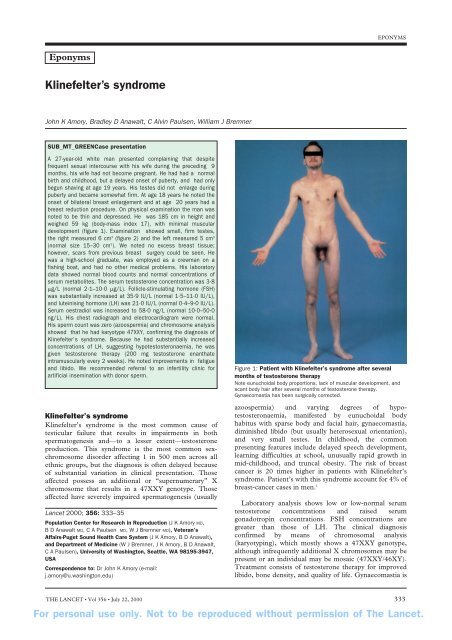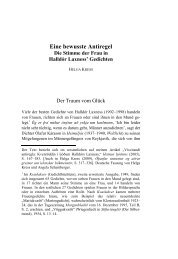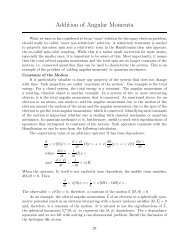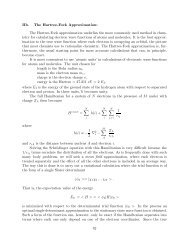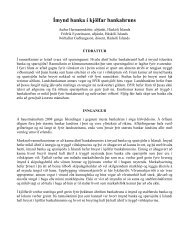Klinefelter's syndrome
Klinefelter's syndrome
Klinefelter's syndrome
You also want an ePaper? Increase the reach of your titles
YUMPU automatically turns print PDFs into web optimized ePapers that Google loves.
Eponyms<br />
Klinefelter’s <strong>syndrome</strong><br />
John K Amory, Bradley D Anawalt, C Alvin Paulsen, William J Bremner<br />
SUB_MT_GREENCase presentation<br />
A 27-year-old white man presented complaining that despite<br />
frequent sexual intercourse with his wife during the preceding 9<br />
months, his wife had not become pregnant. He had had a normal<br />
birth and childhood, but a delayed onset of puberty, and had only<br />
begun shaving at age 19 years. His testes did not enlarge during<br />
puberty and became somewhat firm. At age 18 years he noted the<br />
onset of bilateral breast enlargement and at age 20 years had a<br />
breast reduction procedure. On physical examination the man was<br />
noted to be thin and depressed. He was 185 cm in height and<br />
weighed 59 kg (body-mass index 17), with minimal muscular<br />
development (figure 1). Examination showed small, firm testes,<br />
the right measured 6 cm 3 (figure 2) and the left measured 5 cm 3<br />
(normal size 15–30 cm 3 ). We noted no excess breast tissue;<br />
however, scars from previous breast surgery could be seen. He<br />
was a high-school graduate, was employed as a crewman on a<br />
fishing boat, and had no other medical problems. His laboratory<br />
data showed normal blood counts and normal concentrations of<br />
serum metabolites. The serum testosterone concentration was 3·8<br />
g/L (normal 2·1–10·0 g/L). Follicle-stimulating hormone (FSH)<br />
was substantially increased at 35·9 IU/L (normal 1·5–11·0 IU/L),<br />
and luteinising hormone (LH) was 21·0 IU/L (normal 0·4–9·0 IU/L).<br />
Serum oestradiol was increased to 58·0 ng/L (normal 10·0–50·0<br />
ng/L). His chest radiograph and electrocardiogram were normal.<br />
His sperm count was zero (azoospermia) and chromosome analysis<br />
showed that he had karyotype 47XXY, confirming the diagnosis of<br />
Klinefelter’s <strong>syndrome</strong>. Because he had substantially increased<br />
concentrations of LH, suggesting hypotestosteronaemia, he was<br />
given testosterone therapy (200 mg testosterone enanthate<br />
intramuscularly every 2 weeks). He noted improvements in fatigue<br />
and libido. We recommended referral to an infertility clinic for<br />
artificial insemination with donor sperm.<br />
Klinefelter’s <strong>syndrome</strong><br />
Klinefelter’s <strong>syndrome</strong> is the most common cause of<br />
testicular failure that results in impairments in both<br />
spermatogenesis and—to a lesser extent—testosterone<br />
production. This <strong>syndrome</strong> is the most common sexchromosome<br />
disorder affecting 1 in 500 men across all<br />
ethnic groups, but the diagnosis is often delayed because<br />
of substantial variation in clinical presentation. Those<br />
affected possess an additional or “supernumerary” X<br />
chromosome that results in a 47XXY genotype. Those<br />
affected have severely impaired spermatogenesis (usually<br />
Lancet 2000; 356: 333–35<br />
Population Center for Research in Reproduction (J K Amory MD,<br />
B D Anawalt MD, C A Paulsen MD, W J Bremner MD), Veteran’s<br />
Affairs-Puget Sound Health Care System (J K Amory, B D Anawalt),<br />
and Department of Medicine (W J Bremner, J K Amory, B D Anawalt,<br />
C A Paulsen), University of Washington, Seattle, WA 98195-3947,<br />
USA<br />
Correspondence to: Dr John K Amory (e-mail:<br />
j.amory@u.washington.edu)<br />
EPONYMS<br />
Figure 1: Patient with Klinefelter’s <strong>syndrome</strong> after several<br />
months of testosterone therapy<br />
Note eunuchoidal body proportions, lack of muscular development, and<br />
scant body hair after several months of testosterone therapy.<br />
Gynaecomastia has been surgically corrected.<br />
azoospermia) and varying degrees of hypotestosteronaemia,<br />
manifested by eunuchoidal body<br />
habitus with sparse body and facial hair, gynaecomastia,<br />
diminished libido (but usually heterosexual orientation),<br />
and very small testes. In childhood, the common<br />
presenting features include delayed speech development,<br />
learning difficulties at school, unusually rapid growth in<br />
mid-childhood, and truncal obesity. The risk of breast<br />
cancer is 20 times higher in patients with Klinefelter’s<br />
<strong>syndrome</strong>. Patient’s with this <strong>syndrome</strong> account for 4% of<br />
breast-cancer cases in men. 1<br />
Laboratory analysis shows low or low-normal serum<br />
testosterone concentrations and raised serum<br />
gonadotropin concentrations. FSH concentrations are<br />
greater than those of LH. The clinical diagnosis<br />
confirmed by means of chromosomal analysis<br />
(karyotyping), which mostly shows a 47XXY genotype,<br />
although infrequently additional X chromosomes may be<br />
present or an individual may be mosaic (47XXY/46XY).<br />
Treatment consists of testosterone therapy for improved<br />
libido, bone density, and quality of life. Gynaecomastia is<br />
THE LANCET • Vol 356 • July 22, 2000 333<br />
For personal use only. Not to be reproduced without permission of The Lancet.
EPONYMS<br />
Figure 2: Testicle of patient with Klinefelter’s <strong>syndrome</strong><br />
treated with cosmetic surgery after androgen replacement<br />
has begun. Recent advances in the treatment of male<br />
infertility, including intracytoplasmic injection of sperm<br />
aspirated from the testes of men with Klinefelter’s<br />
<strong>syndrome</strong> have been reported, 2 but for most patients<br />
artificial insemination with donor sperm is the only option<br />
for fertility.<br />
Harry F Klinefelter Jr<br />
Harry F Klinefelter Jr was born in Baltimore, Maryland,<br />
USA on March 20, 1912, and attended the University of<br />
Virginia before entering Johns Hopkins Medical School. 3<br />
After graduating in 1937, he trained in internal medicine<br />
at Johns Hopkins for 3 years. In 1940 he spent a year<br />
working as a “travelling fellow” with one of the founders<br />
of modern endocrinology, Fuller Albright, at the<br />
Massachusetts General Hospital in Boston. At that time,<br />
Fuller Albright was at the height of his formidable<br />
intellectual powers and had wide-ranging interest in the<br />
endocrinology of sexual development, calcium<br />
homeostasis, and the applications of steroid hormone<br />
therapy.<br />
Fuller Albright had been collecting the names of a series<br />
of patients who he felt had an uncharacterised <strong>syndrome</strong><br />
typified by gynaecomastia, very small testes, and varying<br />
degrees of hypogonadism. With characteristic generosity,<br />
Albright assigned Harry Klinefelter the task of further<br />
describing this <strong>syndrome</strong> for publication. Harry<br />
Klinefelter therefore began a study of the medical and<br />
laboratory abnormalities of these patients.<br />
Harry Klinefelter, Fuller Albright, and their colleague<br />
Edward Reifenstein Jr, published their results in the<br />
Journal of Clinical Endocrinology in 1942. 4 They described<br />
a cohort of nine men “characterised by gynecomastia,<br />
aspermatogenesis without a-Leydigism, and increased<br />
excretion of follicle-stimulating hormone.” In this paper,<br />
the investigators noted the presence of Leydig cells in<br />
these patients which produced testosterone, and a<br />
substantial increase in FSH production, comparable to<br />
that seen in castrated men. The investigators suggested<br />
that the substantially increased concentrations of FSH<br />
were caused by the lack of a testicular hormone other than<br />
testosterone. This postulated hormone, called inhibin by<br />
previous researchers, was in fact lacking in these patients,<br />
but it took more than 50 years to confirm their<br />
hypothesis. 5<br />
As to the cause of the <strong>syndrome</strong>, they were less certain.<br />
They ruled out testicular inflammation, infection, or<br />
obstruction of the vas deferens, and noted that the lesion<br />
seen in testicular biopsy samples involved the<br />
seminiferous tubules without affecting the histology of the<br />
Leydig cells, testicular interstitium, or epididymis. They<br />
recommended testosterone therapy (available since the<br />
late 1930s) for those with signs or symptoms of<br />
hypotestosteronism, but noted that this therapy did not<br />
improve the gynaecomastia or fertility.<br />
Following his tenure with Fuller Albright, Harry<br />
Klinefelter served in the US army for 3 years during the<br />
Second World War, advancing from the rank of First<br />
Lieutenant to Major before gaining an honorable<br />
discharge. He then returned to his native Baltimore to<br />
join the medical faculty at Johns Hopkins. He became<br />
interested in rheumatology and began a career in both<br />
private practice and on the clinical faculty, eventually<br />
becoming an Associate Professor of Medicine in 1966.<br />
Harry Klinefelter remained active in patient care in<br />
Baltimore until retiring in 1988 at age 76 years. He died in<br />
1990.<br />
Pathophysiology<br />
After the initial description of the <strong>syndrome</strong> by Harry<br />
Klinefelter, Edward Reifenstein, and Fuller Albright, it<br />
● Klinefelter’s <strong>syndrome</strong> is a common genetic disorder resulting in<br />
testicular failure, variable degrees of androgen deficiency, and<br />
infertility.<br />
● Treatment with testosterone can rectify the androgen deficiency<br />
but does not improve fertility.<br />
● Although developments in assisted-reproductive technology could<br />
make fertility for some patients, artificial insemination with the donor<br />
was another 15 years before I A Jacobs and J A Strong<br />
confirmed the association between the extra Xchromosome<br />
and Klinefelter’s <strong>syndrome</strong>, establishing it as<br />
a genetic disease. 6 Most cases occur through sporadic<br />
chromosomal non-disjunction during parental<br />
gametogenesis in either the sperm (53%) or the egg<br />
(44%). The remaining 3% of cases are caused by<br />
postzygotic mitotic errors. 1 The extra X chromosome<br />
forms a dense chromatin mass, or Barr body, within the<br />
nuclei of somatic cells, but exactly how the presence of<br />
this extra chromosome leads to testicular failure is<br />
unknown. Testicular biopsy samples from infants with<br />
Klinefelter’s <strong>syndrome</strong> sometimes show only a reduced<br />
number of germ cells. After puberty, fibrosis of the<br />
seminiferous tubules begins, eventually leading to small,<br />
firm testes and azoospermia. The lack of functional sertoli<br />
cells in the seminiferous tubules is accompanied by low<br />
concentrations of inhibin B in serum, the hormone whose<br />
existence Harry Klinefelter and his colleagues had<br />
hypothesised in their original paper.<br />
334 THE LANCET • Vol 356 • July 22, 2000<br />
For personal use only. Not to be reproduced without permission of The Lancet.
New developments<br />
There have been recent advances in the options for the<br />
treatment of infertility in patients with Klinefelter<br />
<strong>syndrome</strong>. Until recently, the use of donated sperm or<br />
adoption were the only options available for those patients<br />
who were infertile; however reports of successful,<br />
karyotypically normal pregnancies after intracytoplasmic<br />
injection of sperm, obtained from testicular biopsy<br />
samples from patients with Klinefelter’s <strong>syndrome</strong> have<br />
been published. 2 Although some patients with<br />
Klinefelter’s <strong>syndrome</strong> do not have any sperm, 7 this<br />
technique could offer a chance at fertility for those who<br />
do. However, analysis of these intratesticular germ cells<br />
has shown some spermatozoa with extra X chromosomes,<br />
which is cause for concern. 8 This finding implies that<br />
Klinefelter’s <strong>syndrome</strong> may be transmissible by assisted<br />
reproductive techniques, and that sperm from testicular<br />
biopsy samples might require further selection to prevent<br />
transmission of the <strong>syndrome</strong>.<br />
We thank W Parsons and M Klinefelter for their personal recollections of<br />
EPONYMS<br />
the life of Harry Klinefelter. Physicians and patients interested in<br />
obtaining further information about Klinefelter <strong>syndrome</strong>, including<br />
support-group resources can contact the British Klinefelters Support<br />
Group (www.ksa-uk.co.uk) or the Klinefelter Syndrome and Associates,<br />
PO Box 119, Roseville, CA 95678-0119 (e-mail: ksxxy@ix.netcom.com).<br />
References<br />
1 Smyth CM, Bremner WJ. Klinefelter <strong>syndrome</strong>. Arch Intern Med<br />
1998; 158: 1309–14.<br />
2 Palermo GP, Schlegel PN, Sills ES, et al. Births after intracytoplasmic<br />
injection of sperm obtained by testicular extraction from men with<br />
non-mosaic Klinefelter <strong>syndrome</strong>. N Engl J Med 1998; 338: 588–90.<br />
3 Beighton P, Beighton G. Klinefelter HF Jr. In: The Man Behind the<br />
Syndrome. Berlin: Springer-Verlag, 1986: 214.<br />
4 Klinefelter HF Jr, Reifenstein EC Jr, Albright F. Syndrome<br />
characterized by gynecomastia, aspermatogenesis without a-Leydigism<br />
and increased excretion of follicle-stimulating hormone. J Clin<br />
Endocrinol 1942; 2: 615–27.<br />
5 Anawalt BD, Bebb RA, Matsumoto AM, et al. Serum inhibin B levels<br />
reflect Sertoli cell function in normal men and men with testicular<br />
dysfunction. J Clin Endocrinol Metab 1996; 81: 3341–45.<br />
6 Jacobs PA, Strong JA. A case of human intersexuality having<br />
possible XXY sex-determining mechanism. Nature 1959; 183:<br />
302–03.<br />
7 Gordon DL, Krupotic E, Thomas W, Gandy HM, Paulsen CA.<br />
THE LANCET • Vol 356 • July 22, 2000 335<br />
For personal use only. Not to be reproduced without permission of The Lancet.


